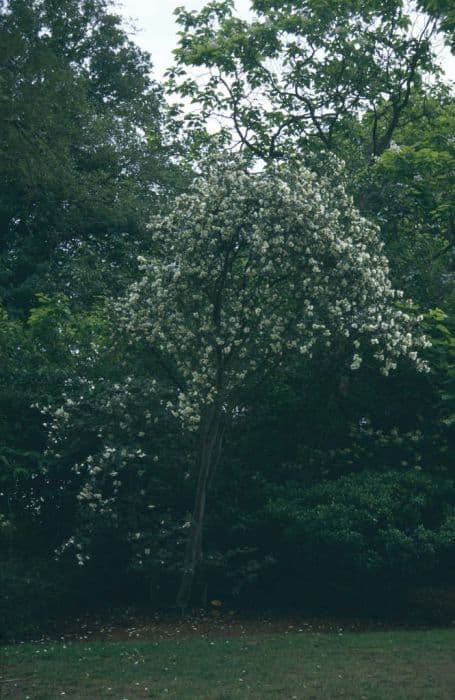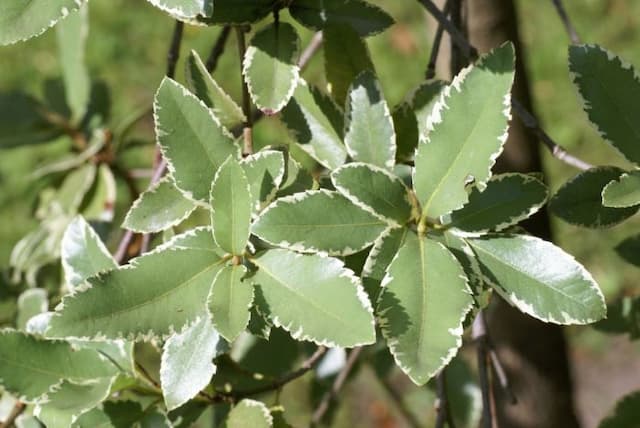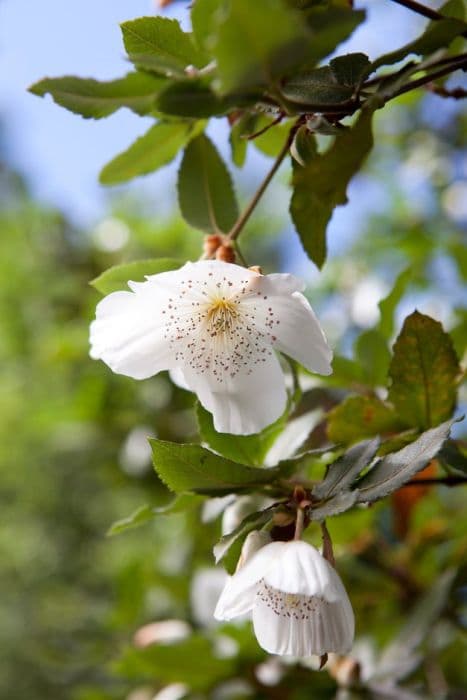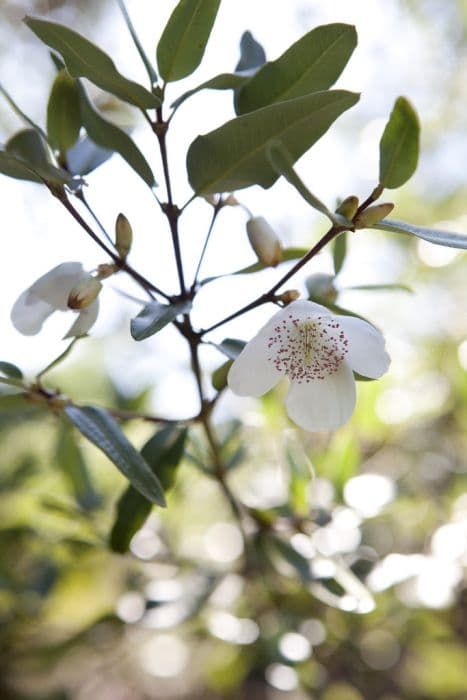Eucryphia lucida 'Gilt Edge' (v)

ABOUT
Eucryphia lucida 'Gilt Edge' is an ornamental plant that is visually striking due to its variegated foliage and floral display. The most prominent feature of this plant is its leaves, which have a distinctive edge colored with a golden-yellow margin, beautifully contrasting the darker green center. The leaves are glossy and leathery to the touch, providing a lush backdrop throughout the year. In the flowering season, 'Gilt Edge' produces a profusion of white blossoms that are particularly eye-catching. These flowers are cup-shaped, and their bright white petals stand out against the variegated leaves, giving the plant an overall showy appearance. These blossoms may attract pollinators to the garden, adding to the dynamic nature of the plant. Overall, the variegation of the foliage, combined with the dazzling white flowers, makes Eucryphia lucida 'Gilt Edge' a favorite among gardeners looking for a plant that provides both year-round interest and seasonal beauty. The golden margins of the leaves catch the light and can brighten shaded areas of the garden, while the white flowers provide a contrast that can enhance the visual appeal of any planting scheme.
About this plant
 Names
NamesFamily
Cunoniaceae
Synonyms
Leatherwood, Tasmanian Leatherwood
Common names
Eucryphia lucida 'Gilt Edge'
 Toxicity
ToxicityTo humans
Leatherwood is not commonly known to be toxic to humans. However, as with any plant, individuals may experience varying sensitivities, and it is generally recommended to avoid ingesting plants that are not established as safe for consumption.
To pets
Leatherwood is not commonly known to be toxic to pets. As with humans, pets may have individual sensitivities, and precaution should be taken to prevent pets from ingesting plants not meant for consumption to avoid any potential adverse effects or gastrointestinal disturbances.
 Characteristics
CharacteristicsLife cycle
Perennials
Foliage type
Evergreen
Color of leaves
Variegated
Flower color
White
Height
10 feet (3.05 meters)
Spread
8 feet (2.44 meters)
Plant type
Shrub
Hardiness zones
9
Native area
Australia Tasmania
Benefits
 General Benefits
General Benefits- Ornamental Appeal: Eucryphia lucida 'Gilt Edge' commonly known as Leatherwood, is appreciated for its striking variegated foliage and bright, creamy-white edges.
- Attractive Flowers: It showcases beautiful white blooms during late summer, adding aesthetic value to gardens.
- Wildlife-friendly: The blossoms provide a nectar source for pollinators such as bees and butterflies, supporting local ecosystems.
- Year-Round Interest: With its evergreen leaves, Leatherwood maintains garden interest throughout all seasons.
- Low Maintenance: It requires minimal pruning and care once established, making it a convenient choice for gardeners of all skill levels.
- Versatile Landscaping Use: Can be used as a specimen plant, for hedging, or in a mixed shrub border due to its dense growth habit and attractive foliage.
 Medical Properties
Medical PropertiesThis plant is not used for medical purposes.
 Air-purifying Qualities
Air-purifying QualitiesThis plant is not specifically known for air purifying qualities.
 Other Uses
Other Uses- Eucryphia 'Gilt Edge’ wood can be used in fine woodworking and cabinetry due to its attractive grain and color.
- The dense foliage of the Eucryphia 'Gilt Edge’ can be used for privacy screening in residential gardens.
- This plant's blossoms are a nectar source for bees, making it useful in supporting local pollinator populations.
- Eucryphia 'Gilt Edge’s' timber is sometimes used in boat building, specifically for its resistance to rot and marine borers.
- The plant can be used in ornamental topiary, as it can be shaped and maintained into formal designs.
- Eucryphia 'Gilt Edge’ can be integrated into a sensory garden; its flowers have a gentle, appealing fragrance.
- This plant may be used in cut flower arrangements; its flowers add elegance and a splash of white to bouquets.
- Eucryphia 'Gilt Edge’ bark can be used as a natural mulch, which can help with soil moisture retention and weed suppression.
- As a plant with distinctive variegated leaves, it can be utilized in photography and painting for studying light and shadow.
- In creative educational programs, parts of Eucryphia 'Gilt Edge’ can help teach botany and plant identification.
Interesting Facts
 Feng Shui
Feng ShuiThe Leatherwood is not used in Feng Shui practice.
 Zodiac Sign Compitability
Zodiac Sign CompitabilityThe Leatherwood is not used in astrology practice.
 Plant Symbolism
Plant Symbolism- Resilience: Eucryphia lucida 'Gilt Edge', commonly known as Leatherwood, is a symbol of resilience due to its ability to thrive in challenging environments, particularly in the Tasmanian rainforest where it naturally occurs.
- Purity: With its bright, white flowers, Leatherwood often embodies purity and innocence, reminiscent of its pristine natural habitat.
- Rarity: As Leatherwood is not commonly found everywhere and is somewhat unique to specific regions, it can also symbolize rarity and preciousness.
- Healing: In some cultures, plants like Leatherwood which have medicinal properties are often associated with healing and therapeutic attributes.
- Endurance: The plant's ability to live for a long time and handle the harsh conditions is a testament to endurance and perseverance.
 Water
WaterLeatherwood plants require even moisture, so it is key to water them consistently without oversaturating the soil. Generally, they should be watered once a week with about 1 to 1.5 gallons of water, ensuring the soil is kept moist but not waterlogged. During hot, dry periods, increase watering frequency to twice a week. In winter, reduce watering to every other week as the plant's water requirements decrease. Always check the soil moisture before watering to prevent overwatering, which can lead to root rot.
 Light
LightLeatherwood plants thrive best in a spot that receives full sun to partial shade. They should be placed where they get at least four to six hours of sunlight daily. However, in areas with very hot summers, it's best to offer afternoon shade to prevent leaf scorch. Ideal placement would be an east or west-facing garden that receives gentle morning or evening sun.
 Temperature
TemperatureLeatherwoods are hardy and can tolerate a range of temperatures, but they grow best in conditions between 50°F and 70°F. They can generally survive winter temperatures as low as 20°F but should be protected from harsh frosts. Leatherwood should ideally be grown in a location that doesn't frequently experience temperature extremes above 85°F or below 20°F to ensure sustained health and growth.
 Pruning
PruningLeatherwood benefits from pruning to maintain shape and promote more vigorous growth. Prune immediately after flowering to shape the plant and remove any dead or damaged branches. Pruning should be done sparingly, as the plant does not require heavy cutting back. Depending on growth, pruning every other year or as needed to remove spent flowers and tidy up the shrub's appearance is generally enough.
 Cleaning
CleaningAs needed
 Soil
SoilLeatherwood 'Gilt Edge' thrives best in well-draining, moist soil with high organic matter. The ideal pH for this plant ranges from slightly acidic to neutral (pH 5.5 to 7). A mix of loam, peat, and sand could work well to provide the necessary drainage and nutrient content.
 Repotting
RepottingLeatherwood 'Gilt Edge' typically does not require frequent repotting as it is often grown as an outdoor shrub. When grown in containers, young plants might need repotting every 2-3 years to ensure they have enough room for root growth.
 Humidity & Misting
Humidity & MistingLeatherwood 'Gilt Edge' prefers moderate to high humidity levels, reflecting its native habitat. It can tolerate lower indoor humidity but benefits from a higher humidity environment if possible.
 Suitable locations
Suitable locationsIndoor
Choose bright, indirect light and keep soil moist.
Outdoor
Plant in partial shade or sun, shelter from strong winds.
Hardiness zone
7-9 USDA
 Life cycle
Life cycleEucryphia lucida 'Gilt Edge', commonly known as Leatherwood or Tasmanian Leatherwood, begins its life cycle as a seed, which after germination yields a small seedling. The seedling then goes through a juvenile vegetative growth stage, developing into a more substantial shrub with characteristic leaves edged in yellow ('Gilt Edge'). As the plant matures, it enters the adult vegetative stage, during which it develops the woody structure typical of shrubs and trees. Following this, the Leatherwood reaches the reproductive stage, producing fragrant white flowers that are attractive to bees and other pollinators. After pollination, the flowers develop into seed capsules, completing the cycle as these capsules release seeds for the next generation. Throughout its life, the Leatherwood experiences seasonal growth cycles, with active growth in the spring and summer and dormancy in the colder months.
 Propogation
PropogationPropogation time
Spring to Early Summer
Eucryphia lucida 'Gilt Edge', commonly known as Leatherwood 'Gilt Edge', is often propagated through semi-hardwood cuttings. This method is most effective when performed in the late summer. Cuttings should be taken from the current season's growth, ensuring they are 4 to 6 inches (approximately 10 to 15 centimeters) long with several leaves. The bottom one-third of the cutting is stripped of leaves and dipped in a rooting hormone to stimulate root growth. The treated cutting is then inserted into a well-draining potting mix. The pot is placed in a warm, humid environment, preferably under a misting system if available, to maintain moisture without waterlogging the cutting. Roots usually develop within a few weeks to a couple of months, after which the young plants can be transplanted into individual pots and gradually acclimatized to outdoor conditions.




